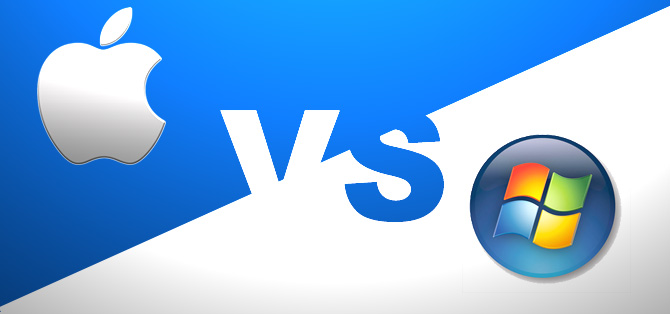One of the big questions people in the video production industry usually find themselves asking at one point or another is — do I get a PC or a Mac?!
Most people tend to be heavily weighted one way or another; usually depending on which system they are most familiar with. There are however, a number of small but crucial factors to each system, which can tip the scales.
Macs Cost More For the Same Horsepower

This argument has been around for a long time. Money for money, you’re simply always going to get more raw power if you invest into a PC rather than a Mac. What you probably won’t get though, is that build quality. Even the biggest mac oppositions can’t quibble about the supreme construction of Apple computers.
Another issue, which has been somewhat resolved with the release of the new Mac Pro is that for editing multiple HD, 4k and 6k tracks — you ideally want the latest hardware in terms of graphics card, processor and ram. With a PC, it’s relatively straightforward to upgrade all of those parts on a semi-regular basis. However, if you’re a Mac user, you can suddenly find yourself severely limited in terms of hardware options. Luckily, if you have the cash, simply investing in the new Mac Pro will keep you ahead of the game in the short term. If you happen to be operating on a mere mortal iMac however, then life can quickly get frustrating as you realize that to properly upgrade your system (beyond simply adding more RAM or a new harddrive), you’ll need to buy an entire new one!
Windows Has The Software

I can’t begin to explain how much software there is for PC. There’s LOADS. To give you a bit of perspective, the Windows store crossed the 50,000 mark in terms of apps available to download after 2 years. To put that into perspective, Apple had a mere 14,000 2 years after launching the apple store.
As video producers, I can imagine you are more interested about industry specific software. The bottom line is, Apple’s Final Cut Pro editing suite does not have professional support anymore and for that reason I wouldn’t recommend it for professional use going forward. Adobe is available on PC, as is Avid and so are almost all other professional video editing packages. This means that in terms of Software, PCs have all the tools. One notable thing that Macs have over PCs (not for long, might I add) is the ProRes codec from Apple. It’s currently only available for Mac which improves the mac desirability score somewhat. That said, I’ve heard rumors it’s going to be available on PC before long — and on top of that we’ve got h.265 to look forward to, which will be available on PC and Mac when it comes out.
General Usability

PC: Windows 7 (the fixed version of Vista) is a very strong filesystem, with a good GUI. It’s pretty easy to use and has various folder options for media files. The vast majority of us grew up operating PCs, and although we began on earlier operating systems, Windows 7 is similar enough for it not to be a huge hurdle to mater compared to an older OS like XP.
Mac: Mac OSX is often described as harder to learn than PC, and it definitely takes a lot longer to master (in my opinion) due to all of the shortcut and gesture options available for it. There are some small quirks in Mac OSX which favor people working with media. One example is the ability to press spacebar with a media file selected, and for it to immediately pop up in preview mode. Another is the file color labeling system, where you can right click a file and designate a color. These functions may sound a bit petty out of useful context, but trust me, they come into their own when you’re working with media every day.

Here is the render folder from my recent Italy trip, as I upload them to Videvo, I simply turn them green. This saves me clicking them and moving them to a new folder after each upload.
Compatibility

Traditionally, Macs earned a reputation for generally being less compatible than PCs due to their unique file structure. This combines with the fact that the majority of software used to be primarily written for PCs, left Mac users feeling a bit left out. The Mac file structure meant that Macs could not write to windows drives which used to be a huge problem for a lot of people, but now thanks to some very clever people, there are programs which let you write to and from windows drives onto and off a mac.
Upgradability

PCs have always held the top spot as far as upgradability goes. I myself bought all of the separate parts for a PC 7 years ago, and since then have simply been upgrading as and when I feel it’s appropriate. 7 years later it’s still top of the range. If I had bought a mac, I would have definitely had to replace the entire thing before now in order to complete the tasks I need to on it.
Maintenance
PC’s require more maintenance than macs. That’s just a fact. Neglecting to de-frag your drive, or update your drivers can suddenly plunge your PC into turmoil. Whereas with Macs, de-fragging is automatically done behind the scenes to keep your machine fresh. It’s important to note though that you should still be de-fragging the drives you render to, as there’s no way to prevent fragmentation when writing huge files.
Security

The vast majority of hackers spend the vast majority of their time causing trouble for the vast majority of computer users. This is why most of the big news about viruses and worms only talks about PC users. With a market share of around 91%, Windows computers are the obvious target. Viruses and malware can still infect Macs, but they are simply less common because a virus made to infect a mac has to be coded differently from the ground up, than a virus to infect a PC.T here are some fantastic security solutions for both PCs and Macs which severely mitigate the threat of infection. Interestingly, a lot of devastating attacks nowadays are coming from social engineering attacks and web-traps, rather than Trojans and worms.
If you’re a video editor this is probably the part you’ve been waiting for! As an editor you need to be able to move data around FAST. You don’t want any laggy playback and you certainly don’t want your editing software to freeze every 5 minutes while it struggles to read multiple media sources.
I have been recently finding that Firewire 800 is beginning to lack the bandwidth I need for post-production jobs. Don’t get me wrong, it’s a good speed and has served me well for years — but I just can’t seem to get slick playback when working on multiple video sources using Firewire, even on my top spec Mac Pro in the Videvo office.
Thunderbolt however is magical, and is definitely a huge plus point to using Macs. But you can achieve this speed easily within your PC by simply installing an SSD. In my PC, I have one of my SSDs as a dedicated scratch disk. I keep all of my footage on it and am able to easily work on big multi-cam edits without any lag. The bandwidth for SSD storage is so high, and the prices are getting lower by the month.
Both Platforms Work For Video

Back in the 80’s and 90’s, Macs legitimately held the top spot for designers of all digital media due to it’s superior selection of applications. It’s a lot more common now for macs to be the machine of choice simply out of habit, or due to a stereotypical belief that Apple is superior.
Due to the fact that Apple is no longer in possession of powerful exclusive designer tools, I think it’s safe to say that PC has caught up with Apple as far as usability for video production is concerned; on the basis that you can now get industry standard software on both operating systems. Apple might have a slight advantage towards workflow due to tools built into the OS, such as the font manager and preview, but at the end of the day it’s going to come down to personal preference. The scope is there for both systems, but of course it’s up to you which one you go for.
Thanks for reading,
Harry – Videvo.net





